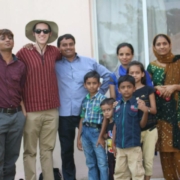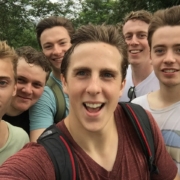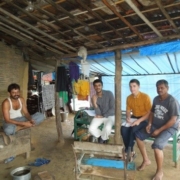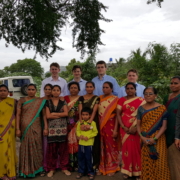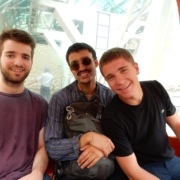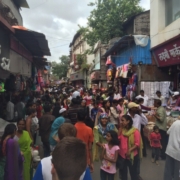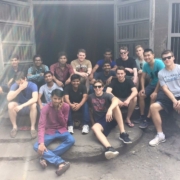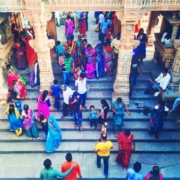Self-Employed Women’s Association 2014 – Week 4
Rather than the usual Monday morning, this week we were treated to a trip to the Calico Museum of Textiles, one of the most popular tourist attractions in Ahmedabad, and considered essential to our work (I was informed that my supervisors would not allow me to leave the city without paying the museum a visit).
The museum was based on a carved wooden house, traditional to Gujurat, which was over 200 years old and could be broken down and transported, which is a very interesting detail.
Once inside the museum, we were bombarded with textiles on every wall, floor and ceiling. The early sections boasted fabrics and cloths from the 15th Century. As our guide pointed out, some of the shapes were not the most flattering, but “they did their best.” As we moved deeper into the museum, we learned more and more about different embroidery and decorative techniques, from the very small and neat cobblers’ stitch (developed by cobblers using hooks to sew leather shoes), to the precision of the Punjabi embroidery style, whereby the embroidery would count the threads the stitch would cover to create perfect geometric designs.
The traditional techniques of people in Gujurat and other Indian states were all on show in the museum. One large hall was completely covered in an intricate canvas tent from the Mughal period, along with modesty screens, which they used to allow women to observe without being seen.
Each room in the museum had a different theme and so we were able to walk from a room of quilted, 3D designs to one in which everything was covered in tiny beads, painstakingly sewn together in complex designs and patterns. In some of the later rooms we learnt more about styles such as tie dye and weaving. One technique involved the weaver dyeing every single thread individually in multiple colors so that once they were all woven together a design was created. The artisans creating such pieces would have no written instructions, but would translate designs from their mind’s eye to the loom. Other hand-embroidered pieces would take two artisans up to three years to complete, with each embroiderer starting from opposite ends and working towards the middle, creating a symmetrical design. Each stage in designs such as this were passed on through song, with the artisan creating the design, singing the instructions to their partner at the other end.
I think we were all thoroughly impressed by the meticulous skills of these artisans, and their patience!
On Tuesday night we decided to go out for dinner to celebrate the return of our very own prodigal sons (also known as the EDI boys). The plan was to meet at the beautiful Kankaria Lake; however, some of us got a little side-tracked, staging a daring rescue of an injured bird with the help of our trusted rickshaw driver, Manglesh. Instead of going to the lake, we instead went to a veterinary clinic that accepted injured animals off the street (for the cynical amongst you, they had a huge enclosure full of pigeons so I’m confident that they didn’t just put our little bird down). There we encountered an adorable little dog, locked in a cage with a bandaged leg, yapping inconsolably. When we asked why no one had changed his bloody bandage, we were informed that it was in fact rabid. Oh.
On Thursday I was lucky enough to visit Jamie’s work place, known as Gitanjili. Here I had the chance to meet some of the waste pickers who had joined SEWA and now worked making recycled stationary. I was immediately impressed by all the Gujurati Jamie had learned, as she was able to hold a pretty decent conversation with the women there. I, however, had absolutely no clue what was going on, but managed to make friends whilst learning their special paper counting technique (which was actually much harder than it looked!) Overall, Jamie and I had a lovely time, with Jamie conducting interviews with some of the workers whilst I struggled to get the right paper flicking technique. That was until The Rain became ridiculous. Yes, I have deliberately capitalized and italicized The Rain in line with my new found respect for the beast.
At around 4 o’clock, one of the ladies came upstairs to ask how Jamie and I were planning to get home. We were confused by the question until we looked down the stairs and saw the water level standing at lower shin depth on the street outside, despite the fact that the road was sloped.
Initially Jamie’s supervisor Neelimaben was going to come to our rescue, offering to take us in her car to a point where the water wasn’t so bad so our rickshaw driver could collect us. This plan was quickly scrapped, however, when we saw the parade of broken rickshaws outside the gate, including one which had been washed onto its side. Eventually we decided that we would have to brave it and walk to meet our rickshaw on higher ground.
As we made our way through the gate we were met by our very soggy rickshaw driver sans rickshaw (he had, however, brought along his trusty radio wrapped in a plastic bag). He informed us we would have to walk through knee deep water to get to the rickshaw. He lied. Jamie and I are not the tallest people in the world anyway, but by the time we made it to “the puddle,” things had become somewhat worse. The water was up to the tops of our thighs and we had to wade a good 100 meters through it. Never have I tried harder to put mind over matter. I still refuse to think about what must have been in that dark brown water…
Nevertheless, Jamie and I survived the ordeal and lived to see another day (meaning a hot shower involving epic amounts of hand sanitizer and soap!)
So yes, just another quiet week in India…

